Panax trifolius, dwarf ginseng, is a native perennial herbaceous plant. It has male and female flowers on separate plants and also perfect flowers. Dwarf ginseng has a very unusual life cycle that undergoes "sex/gender change". It blooms late April/early May and greenish yellow fruits mature quickly. It is a true spring ephermal and in about 2 months it will be gone underground.
This is in our spring photo gallery collection.
Flowers
Inflorescence - flower cluster:
The small white dwarf ginseng flower cluster is less than a inch wide. There is only one cluster per plant on the single short vertical stem.
From the top, the flower cluster looks ball shaped. The flowers mature starting from the bottom up so the buds are at the center. The third photo is a side view.
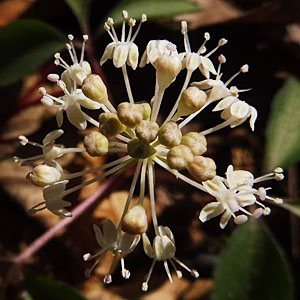
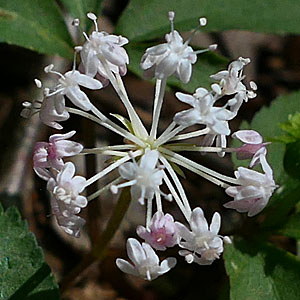
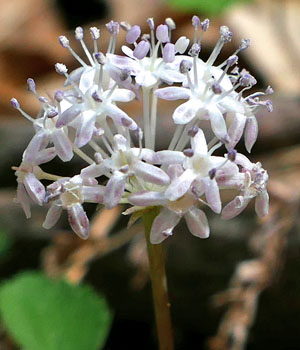
Individual flowers:
The dwarf ginseng individual flowers are less than an 1/8 th inch across. On closer exammination, there are basically two types of flowers, each kind growing on separate plants. The flowers all have 5 petals and 5 stamens.
Male flowers/plants:
The male flowers have fertile stamens. The photos show a single short style but the pistil is sterile.
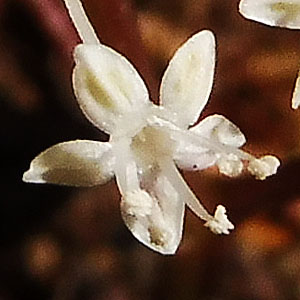

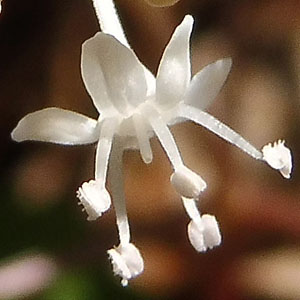
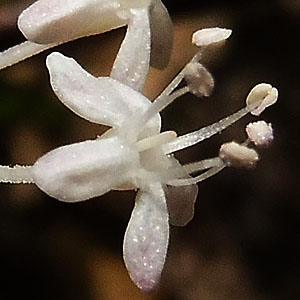
Female and Bisexual (hermaphroditic, perfect) flowers/plants: We found some plants where all the flowers had only pistils. There were no stamens. All the stamens could have fallen off or did not emerge yet. On the internet, only one site, "Go Botany" mentioned that the flowers could be female only. All the remainder of the sites I found mentioned only male and bisexual/ hermaphroditic flowers. The bisexual flowers have both fertile stamens and fertile pistils.
The images below show female only flowers. The pistil is compound with a 3-celled ovary with 3 stigmas. The stigmas are clearly seen. No stamens are apparent. All the flowers on the plant were the same.

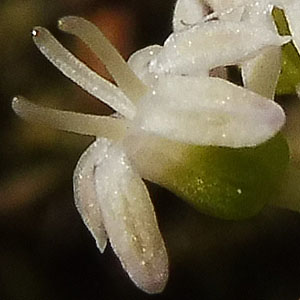
The images below show bisexual flowers. The 5 stamens and 3 functional stigmas are apparent.
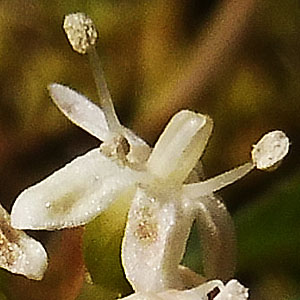
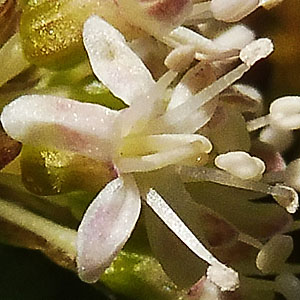
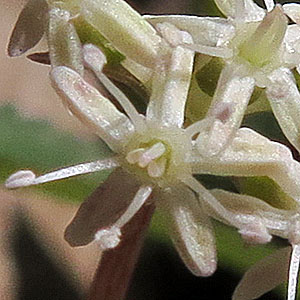
Dwarf ginseng plant life cycle and "sex/gender change":When the plants are very small they do not bear flowers and only produce leaves. When they are first large enough to have flowers, the flowers will be male. Producing pollen requires less stored energy. When the plants are large enough, they will produce bisexual flowers. These plants with functional pistils will produce fruit and consequently will need more stored energy to support the seed production process. This has often referred to as a "sex change". After producing seed, the plant will in the following year most likely produce male flowers.
Studies have shown that the plants can alternate between the two different genders during their life time. It has been estimated that every year about one fourth to one third of the plants in an area switch from producing one kind of flower to the producing the other. This a rare sexual system.
Both forms of the plant produce viable pollen. Comparing the male plant stamens to the bisexual plant stamens, studies have shown that the male plants produce more flowers - 2-3 times more. The male plant anthers produce more pollen per anther, about 1.2 time more. The male plant pollen is available for a longer time and the timing coincides closely with the time the stigmas are ready. The bisexual plant stamens produce pollen for a shorter period of time and the pollen is available before the stigmas are ready discouraging self fertilization and favoring cross pollination by the male plants.
Fruit
After the female and bisexual flowers are fertilized, the fruits begin to develop. The base of the flowers, ovary, with functional pistils start off relatively broader and develop further as the fruits mature. The leaves turn yellow and the plant falls over
The petals fall off, the stigmas remain. Stamens are not apparent in the first photo below. In the first 2 photos, the leaves are still functional. The base of the flower, ovaries, expand.
In the last 3 photos, the fruit may be ripening but resources from the leaves are diminishing. In the last photo, two fruits are ripening and two have aborted.
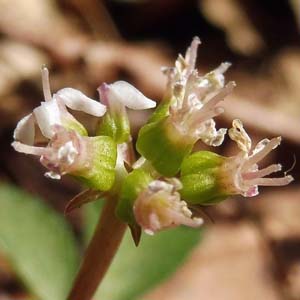
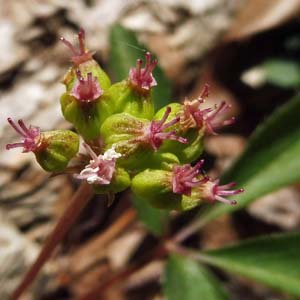
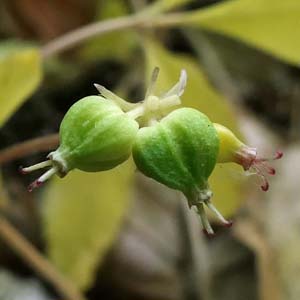
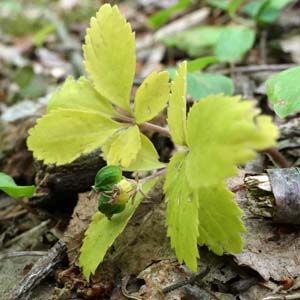
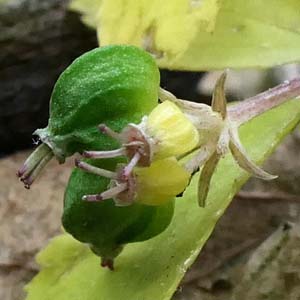
Leaves and Plant
The single stem of the plant terminates in a whorl of compound leaves and a single flowering stalk close to the ground.
The whorl of 3 leaves each with 3-5 leaflets. Individual leaflets are 0.75 to 1.5 inches long. The plant including the flower is about 3 - 8 inches tall. Underground, each plant has a small corm about the size of a pea which is the perennial energy storage part of the plant.
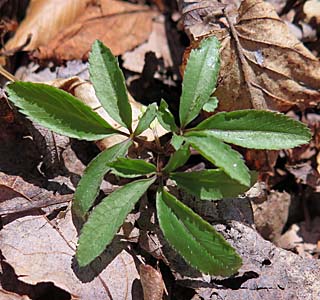
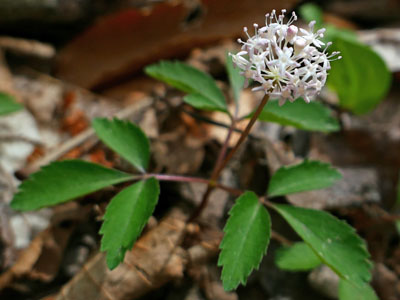
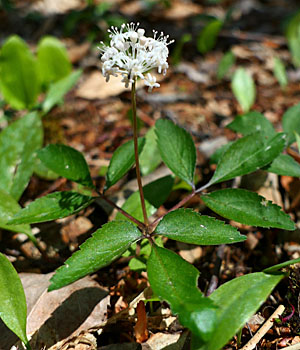
Habitat
Dwarf ginseng grows in moist humus rich soil in shady areas in hardwood forests. In NJ it is found mainly in the north . Photos show the leaf litter and some companion plants - trout lily and wild lily of the valley.
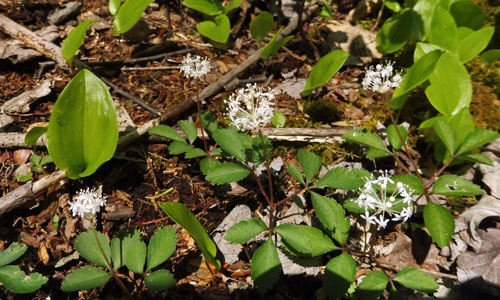

All photos by H & M Ling. Photos taken April 6, to June 1, 2020 in the Morris County.
Additional information
Additional information / references:
References on life cycle & "sex change":
Mark Schlessman has done many scholarly studies on dwarf ginseng. Here is one:
Article can be downloaded from here: https://www.researchgate.net/publication/271774861_Floral_Phenology_of_Sex-Changing_Dwarf_Ginseng_Panax_trifolium_L_Araliaceae
This article give many references: https://www.discoverlife.org/nh/tx/Plantae/Dicotyledoneae/Araliaceae/Panax/trifolium/
Article from Georgia: https://georgiabiodiversity.a2hosted.com/natels/profile?es_id=16616
Plant descriptions and photos:
This site always has good descriptions: https://www.minnesotawildflowers.info/flower/dwarf-ginseng
This site always has great photos : https://www.delawarewildflowers.org/plant.php?id=1382